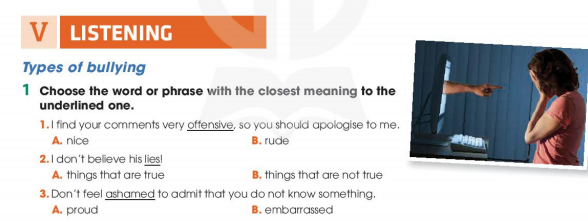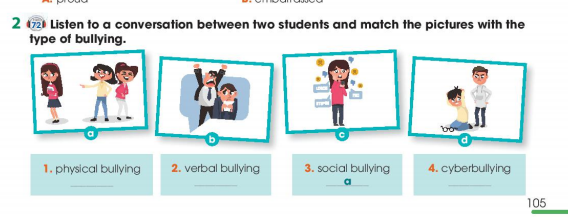Tiếng Anh 11 Global Success Unit 9 Listening
Tiếng Anh 11 Unit 9 Listening
Nằm trong bộ tài liệu Giải tiếng Anh 11 Kết nối tri thức theo từng Unit, Soạn tiếng Anh 11 Unit 9 Listening giúp các em chuẩn bị bài tập SGK tiếng Anh hiệu quả.
Types of bullying (Các kiểu bắt nạt người khác)
1. Choose the word or phrase with the closest meaning to the underlined one.
(Chọn từ hoặc cụm từ có nghĩa gần nhất với từ được gạch chân.)

Gợi ý đáp án
|
1. B |
2. B |
3. B |
2. Listen to a conversation between two students and match the pictures with the type of bullying.
(Nghe đoạn hội thoại giữa hai học sinh và nối các bức tranh với kiểu bắt nạt.)
Bài nghe

Gợi ý đáp án
|
1. d |
2. b |
3. a |
4. c |
Nội dung bài nghe
Mai: So at our club meeting last time, we decided to plan our campaign around bullying among teenagers. We also thought that it'd be useful to do some research on the topic before this meeting. So what have you found out, Mark?
Mark: Well I've learned that there are three main types of bullying-physical, verbal, and social bullying.
Mai: I guess physical bullying involves violent behaviour such as hitting, kicking, or pushing people.
Mark: That's right. And verbal bullying means using words to attack others, such as shouting at, or saying something offensive to them.
Mai: What about social bullying?
Mark: Well, it happens when people keep telling lies or bad things about someone behind their back, or making them feel ashamed in public.
Mai: That's very mean. As we use more technology, bullying is also becoming more common on social media.
Mark: That's cyberbullying, which takes place over digital devices such as mobile phones and computers. People sometimes tell lies or post offensive comments about someone else on social media.
Mai: My friend was the victim of cyberbullying. Some people kept posting very rude comments about her weight on social media. She became very upset and cried a lot.
Mark: I'm sorry about your friend. Body shaming is now one of the most common forms of cyberbullying.
Mai: I agree. So let's meet next week and start planning our campaign.
3. Listen again. Circle the correct answers.
(Lắng nghe một lần nữa. Khoanh tròn các câu trả lời đúng.)
Bài nghe

Gợi ý đáp án
|
1. more |
2. was bullied by others |
3. cyberbullying |
4. how |
4. Work in groups. Discuss the following question.
(Làm việc nhóm. Thảo luận câu hỏi sau.)
What types of bullying have you experienced or seen happening to people around you?
(Kiểu bắt nạt nào bạn đã chứng kiến hoặc nhìn nó xảy ra xung quanh bạn?)
Gợi ý đáp án
John was a high school student who loved playing basketball and had a passion for music. However, his experience at school was not what he had hoped for. He was often targeted by a group of students who would call him names, shove him in the hallways, and post hurtful comments about him on social media.
Despite trying to ignore the bullying, it continued to escalate, and John's grades began to suffer. He started skipping classes, feeling anxious and depressed, and avoiding his friends and family.
One day, the bullying took a physical turn when a group of students assaulted John after school. They beat him severely, leaving him with multiple injuries and a long road to recovery. The incident was captured on video and quickly went viral on social media, sparking outrage among the community.
The school administration took swift action, expelling the students responsible for the attack and implementing new policies to prevent bullying. John received an outpouring of support from his community, and he used his experience to become an advocate for anti-bullying initiatives.
Although the consequences of the bullying were severe, John's story brought attention to the issue of bullying and the need for schools to take a more proactive approach in preventing it. Through his advocacy work, John helped to create a safer environment for students and inspired others to speak up against bullying.
Trên đây là Soạn tiếng Anh 11 Global Success Unit 9 Listening đầy đủ nhất.








